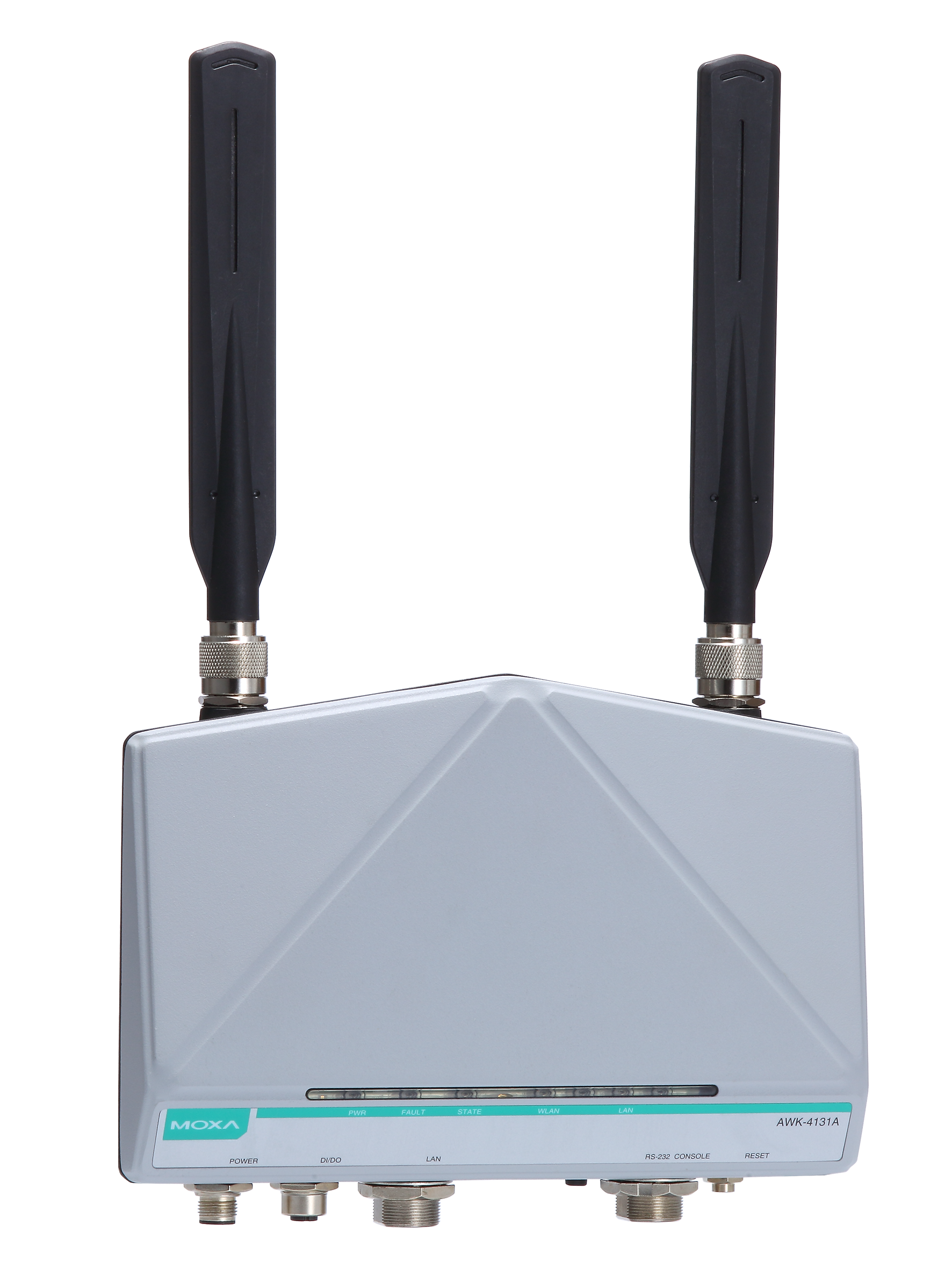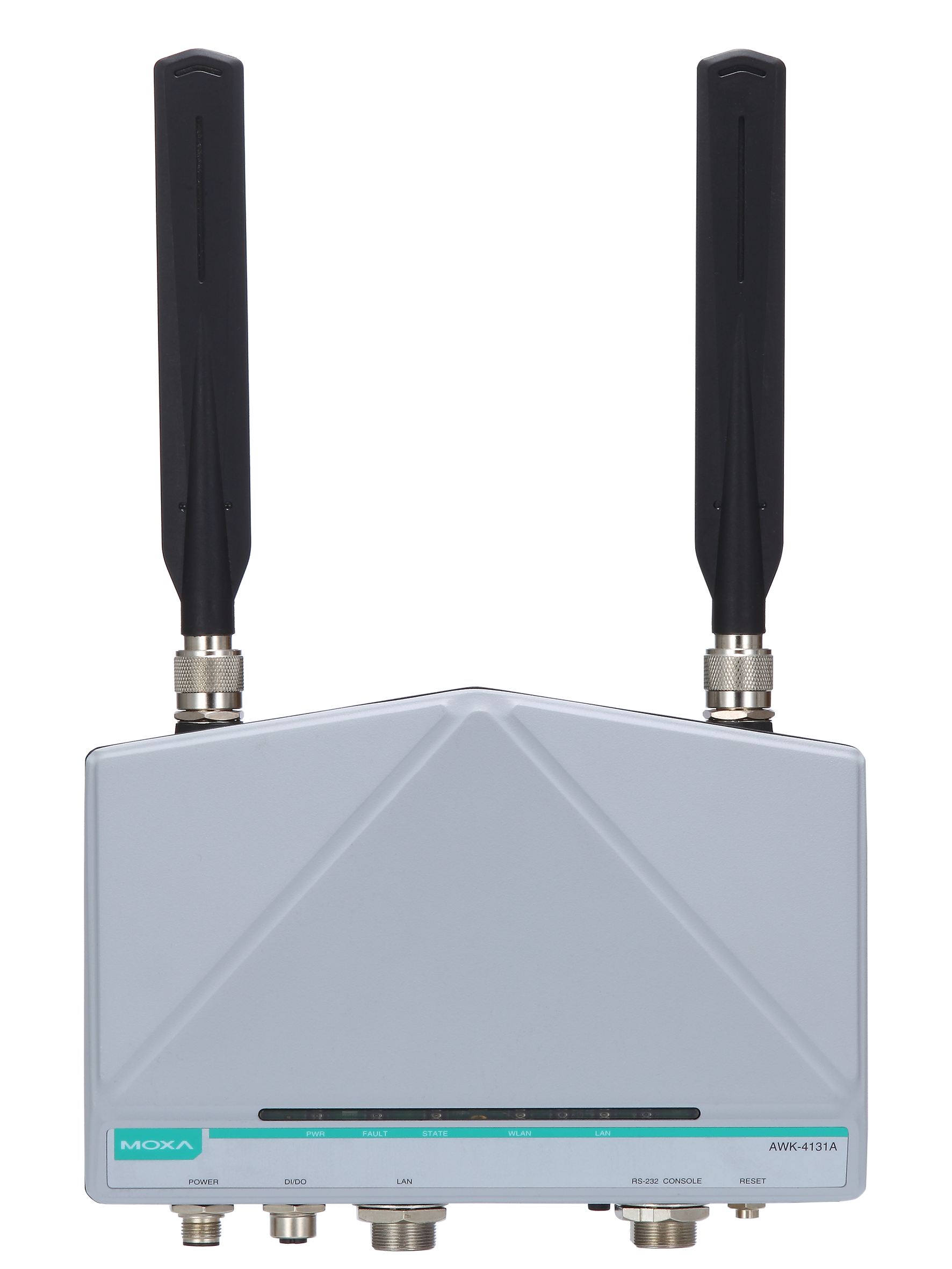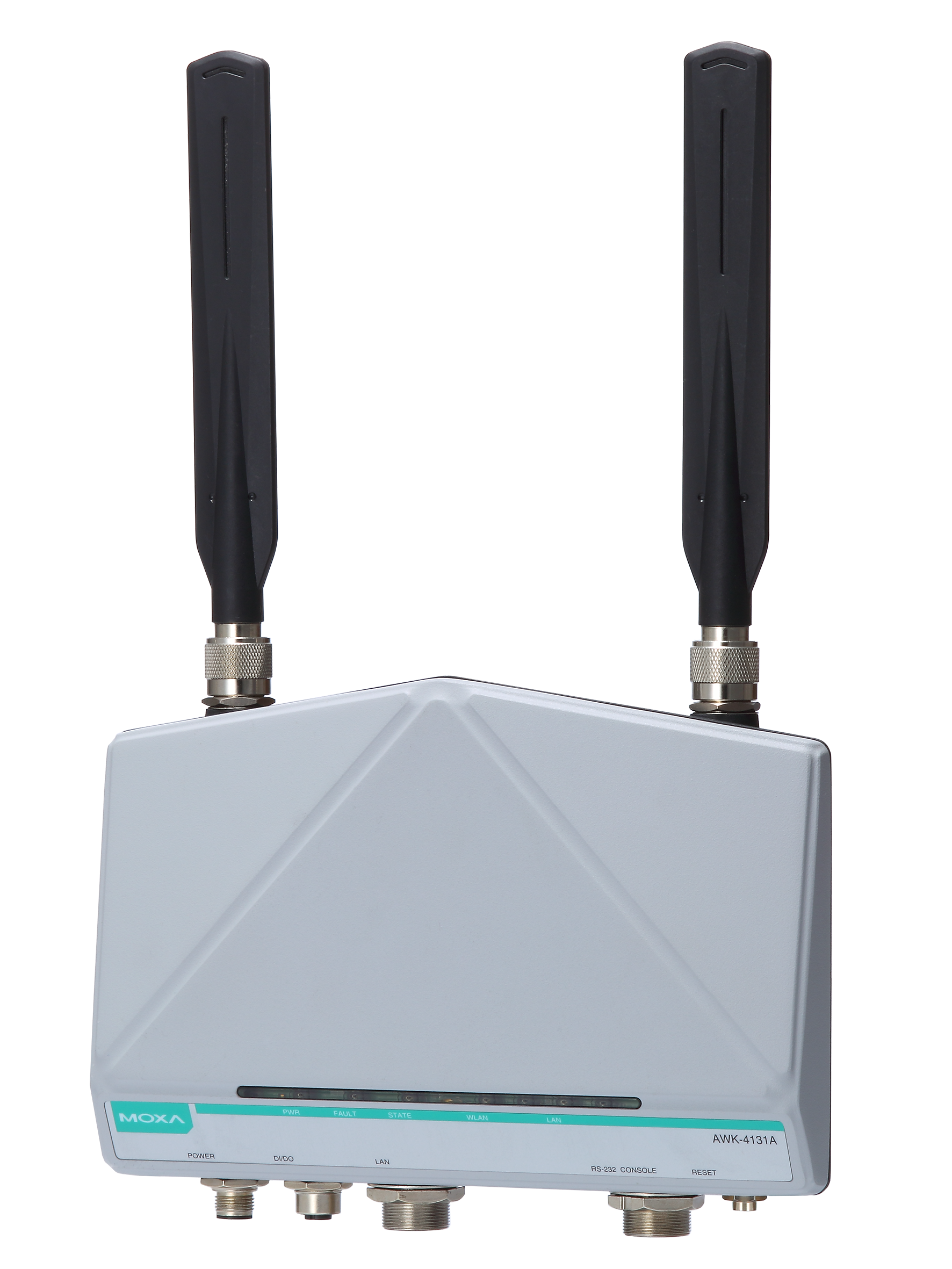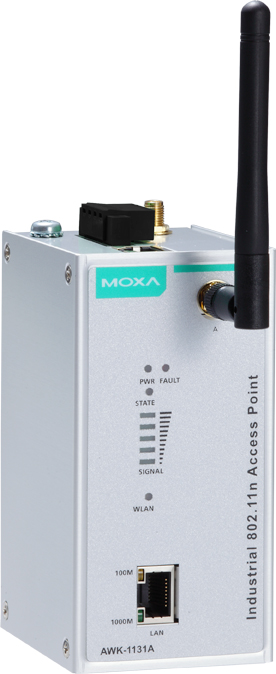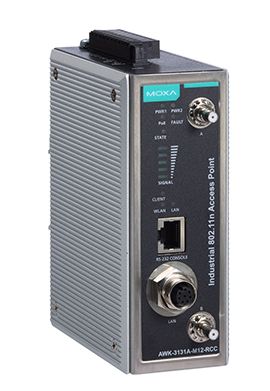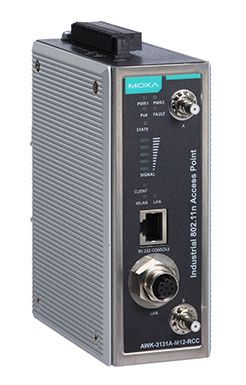-
Overview
-
Specifications
-
Downloads
-
Overview
The AWK-4131A IP68 outdoor industrial AP/bridge/client meets the growing need for faster data transmission speeds by supporting 802.11n technology and allowing 2X2 MIMO communication with a net data rate of up to 300 Mbps. The AWK-4131A is compliant with industrial standards and approvals covering operating temperature, power input voltage, surge, ESD, and vibration. The two redundant DC power inputs increase the reliability of the power supply, and the AWK- 4131A can be powered via PoE to make deployment easier. The AWK- 4131A can operate on either the 2.4 or 5 GHz bands and is backwardscompatible with existing 802.11a/b/g deployments to future-proof your investments in wireless networks.
Advanced 802.11n Industrial Wireless Solution
- 802.11a/b/g/n compliant AP/bridge/client for flexible deployment
- Software optimised for long distance (LoS, 1 km) wireless communication
- with external high-gain antenna (available on 5 GHz)
- Supports 60 clients connected concurrently
- DFS channel support allows a wider range of 5 GHz channel selection
- to avoid existing wireless infrastructure and interference
Advanced Wireless Technology for Mission-Critical Applications
- Seamless roaming with Client-based Turbo Roaming for < 150 ms
- roaming recovery time between APs (Client mode)
- Supports AeroLink Protection for creating a redundant wireless link
- (< 300 ms recovery time) between AP and clients (Client mode)
Industrial Ruggedness
- Integrated antenna and power isolation designed to provide 500 V insulation
- protection against external electrical interference
- IP68 rated metal casing for complete ingress protection for any outdoor weather
- -40 to 75°C wide operating temperature provided for smooth wireless
- communication in harsh environments
-
Specifications
| WLAN Interface | |
| Standards | IEEE 802.11a/b/g/n for Wireless LAN IEEE 802.11i for Wireless Security IEEE 802.3 for 10BaseT IEEE 802.3u for 100BaseT(X) IEEE 802.3ab for 1000BaseT IEEE 802.3af for Power-over-Ethernet IEEE 802.1D for Spanning Tree Protocol IEEE 802.1w for Rapid STP IEEE 802.1Q for VLAN |
| Spread Spectrum and Modulation (typical) | • DSSS with DBPSK, DQPSK, CCK • OFDM with BPSK, QPSK, 16QAM, 64QAM • 802.11b: CCK @ 11/5.5 Mbps, DQPSK @ 2 Mbps, DBPSK @ 1 Mbps • 802.11a/g: 64QAM @ 54/48 Mbps, 16QAM @ 36/24 Mbps, QPSK @ 18/12 Mbps, BPSK @ 9/6 Mbps • 802.11n: 64QAM @ 300 Mbps to BPSK @ 6.5 Mbps (multiple rates supported) |
| Operating Channels (central frequency) | US: 2.412 to 2.462 GHz (11 channels) 5.180 to 5.240 GHz (4 channels) 5.260 to 5.320 GHz (4 channels)* 5.500 to 5.700 GHz (8 channels, excluding 5.600 to 5.640 GHz)* 5.745 to 5.825 GHz (5 channels) EU: 2.412 to 2.472 GHz (13 channels) 5.180 to 5.240 GHz (4 channels)* 5.260 to 5.320 GHz (4 channels) 5.500 to 5.700 GHz (11 channels)* JP: 2.412 to 2.484 GHz (14 channels) 5.180 to 5.240 GHz (4 channels) 5.260 to 5.320 GHz (4 channels)* 5.500 to 5.700 GHz (11 channels)* |
| *DFS (Dynamic Frequency Selection) channel support | In AP mode, when a radar signal is detected, the device will automatically switch to another channel. However according to regulations, after switching channels, a 60-second availability check period is required before starting the service. |
| Security | • SSID broadcast enable/disable • Firewall for MAC/IP/Protocol/Port-based filtering • 64-bit and 128-bit WEP encryption, WPA /WPA2-Personal and Enterprise (IEEE 802.1X/RADIUS, TKIP and AES) |
| Transmission Rates | 802.11b: 1, 2, 5.5, 11 Mbps 802.11a/g: 6, 9, 12, 18, 24, 36, 48, 54 Mbps 802.11n: 6.5 to 300 Mbps (multiple rates supported) |
| TX Transmit Power | 802.11b: • Typ. 26±1.5 dBm @ 1 Mbps, Typ. 26±1.5 dBm @ 2 Mbps • Typ. 26±1.5 dBm @ 5.5 Mbps, Typ. 25±1.5 dBm @ 11 Mbps 802.11g: • Typ. 23±1.5 dBm @ 6 to 24 Mbps, Typ. 22±1.5 dBm @ 36 Mbps • Typ. 20±1.5 dBm @ 48 Mbps, Typ. 19±1.5 dBm @ 54 Mbps 802.11n (2.4 GHz): • Typ. 23±1.5 dBm @ MCS0/8 20 MHz, Typ. 18±1.5 dBm @ MCS7/15 20 MHz • Typ. 23±1.5 dBm @ MCS0/8 40 MHz, Typ. 17±1.5 dBm @ MCS7/15 40 MHz 802.11a: • Typ. 23±1.5 dBm @ 6 to 24 Mbps, Typ. 21±1.5 dBm @ 36 Mbps • Typ. 20±1.5 dBm @ 48 Mbps,Typ. 18±1.5 dBm @ 54 Mbps 802.11n (5 GHz): • Typ. 23±1.5 dBm @ MCS0/8 20 MHz, Typ. 18±1.5 dBm @ MCS7/15 20 MHz • Typ. 23±1.5 dBm @ MCS0/8 40 MHz, Typ. 18±1.5 dBm @ MCS7/15 40 MHz |
| Note | Based on regional regulations, the maximum transmission power allowed on the UNII bands is restricted in the firmware, as per the following list: |
| Table | |
| RX Receive Sensitivity | 802.11b: • -93 dBm @ 1 Mbps, -93 dBm @ 2 Mbps • -93 dBm @ 5.5 Mbps, -88 dBm @ 11 Mbps 802.11g: • -88 dBm @ 6 Mbps, -86 dBm @ 9 Mbps • -85 dBm @ 12 Mbps, -85 dBm @ 18 Mbps • -85 dBm @ 24 Mbps, -82 dBm @ 36 Mbps • -78 dBm @ 48 Mbps, -74 dBm @ 54 Mbps 802.11n (2.4 GHz): • -70 dBm @ MCS7 20 MHz, -69 dBm @ MCS15 20 MHz • -67 dBm @ MCS7 40 MHz, -67 dBm @ MCS15 40 MHz 802.11a: • -90 dBm @ 6 Mbps, -88 dBm @ 9 Mbps • -88 dBm @ 12 Mbps, -85 dBm @ 18 Mbps • -81 dBm @ 24 Mbps, -78 dBm @ 36 Mbps • -74 dBm @ 48 Mbps, -72 dBm @ 54 Mbps 802.11n (5 GHz): • -69 dBm @ MCS7 20 MHz, -71 dBm @ MCS15 20 MHz • -63 dBm @ MCS7 40 MHz, -68 dBm @ MCS15 40 MHz |
| Protocol Support | |
| General Protocols | Proxy ARP, DNS, HTTP, HTTPS, IP, ICMP, SNTP, TCP, UDP, RADIUS, SNMP, DHCP, VLAN, STP/RSTP |
| Interface | |
| Default Antennas | 2 dual-band omni-directional antennas, 5 dBi at 2.4 GHz, 2 dBi at 5 GHz, N-type (male) |
| Connector for External Antennas | N-Type (female), 500 V insulation |
| LAN Ports | 1, RJ45, 10/100/1000BaseT(X) auto negotiation speed, F/H duplex mode, and auto MDI/MDI-X connection |
| Console Port | RS-232 (waterproof RJ45-type) |
| Reset | Present |
| LED Indicators | PWR, FAULT, STATE, WLAN, LAN |
| Alarm Contact (digital output) | M12 connector, 1 relay output with current carrying capacity of 1 A @ 24 VDC |
| Digital Inputs | M12 connector, 2 electrically isolated inputs• +13 to +30 V for state “1” • +3 to -30 V for state “0” • Max. input current: 8 mA |
| Management | |
| Device Management | Wireless Search Utility, MXconfig, SNMP |
| Network Monitoring | MXview |
| Physical Characteristics | |
| Housing | Metal, IP68 protection |
| Weight | 1400 g (3.09 lb) |
| Dimensions | 224 x 148 x 67 mm (8.82 x 5.82 x 2.62 in) |
| Installation | Wall mounting (standard), DIN-rail mounting (optional), pole mounting (optional) |
| Environmental Limits | |
| Operating Temperature | -40 to 75°C (-40 to 167°F) |
| Storage Temperature | -40 to 85°C (-40 to 185°F) |
| Ambient Relative Humidity | 5% to 95% (non-condensing) |
| Power Requirements | |
| Input Voltage | 12 to 48 VDC, redundant dual DC power inputs or 48 VDC Power-over-Ethernet (IEEE 802.3af compliant) |
| Input Current | 0.64 A @ 12 VDC; 0.16 A @ 48 VDC |
| Connector | M12 A-coding connector (male), 500 V insulation |
| Power Consumption | 7.68 W |
| Reverse Polarity Protection | Present |
| Standards and Certifications | |
| Safety | UL 60950-1, EN 60950-1 |
| EMC | EN 61000-6-2/6-4 |
| EMI | CISPR 22, FCC Part 15B Class B |
| EMS | IEC 61000-4-2 ESD: Contact 8 kV; Air 15 kV IEC 61000-4-3 RS: 80 MHz to 1 GHz: 10 V/m IEC 61000-4-4 EFT: Power 2 kV; Signal 1 kV IEC 61000-4-5 Surge: Power 2 kV; Signal 1 kV IEC 61000-4-6 CS: 10 V IEC 61000-4-8 |
| Radio | EN 301 489-1/17, EN 300 328, EN 301 893, TELEC, FCC ID SLE-WAPN008 |
| Note | Please check Moxa’s website for the most up-to-date certification status. |
| MTBF (mean time between failures) | |
| Time | 440,764 hrs |
| Standard | Telcordia SR332 |
| Warranty | |
| Warranty Period | 5 years |
| Details | See www.moxa.com/warranty |
| WLAN Interface | |
| Operating Channels (central frequency) | US: 2.412 to 2.462 GHz (11 channels) 5.180 to 5.240 GHz (4 channels) 5.260 to 5.320 GHz (4 channels)* 5.500 to 5.700 GHz (8 channels, excluding 5.600 to 5.640 GHz)* 5.745 to 5.825 GHz (5 channels) EU: 2.412 to 2.472 GHz (13 channels) 5.180 to 5.240 GHz (4 channels)* 5.260 to 5.320 GHz (4 channels) 5.500 to 5.700 GHz (11 channels)* JP: 2.412 to 2.484 GHz (14 channels) 5.180 to 5.240 GHz (4 channels) 5.260 to 5.320 GHz (4 channels)* 5.500 to 5.700 GHz (11 channels)* *DFS (Dynamic Frequency
|
